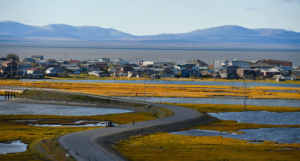Smartphone footage of police brutality highlights a dire need to tell more humane stories about Black victims.
Jacob Blake is a father. He has, perhaps, a growing collection of dad jokes, a birth story for each of his three sons, and, most important, a deep reservoir of Black family history to pass down to them. He likely had a gift picked out for his eldest son’s August 23 birthday celebration, which should have been the highlight of the weekend. Maybe Blake even had a bedtime tuck-in routine that would have ended that Sunday on a loving note.
This is what I thought after I viewed the now-viral smartphone video, which depicts police in Kenosha, Wisconsin, shooting Blake in the back multiple times as his children watched from the back seat of his car. Once again, the nation has seen ghastly bystander footage of state violence. And, once again, the video has eclipsed the most essential thing to remember about this story: that this latest incident of police brutality happened to a human being.
On one hand, bystander video can provide striking visuals for stories of police misconduct that might have otherwise gone unreported or been outright fabricated. Smartphone footage from brave witnesses has given Black families evidentiary proof of excessive police force against Oscar Grant, Eric Garner, Philando Castile, and so many others. On the other hand, these same videos have performed a sinister function. When police in these clips go unpunished—and when news media fail to humanize Black victims adequately—this footage reaffirms the continued, centuries-long annihilation of a people. The imagery, then, feels sacrilegious to watch.
[Read: Korryn Gaines and the conflicts between Black women and the police]
When there is video of violence against a Black person, their abuse or their killing—and not their life—often becomes the central narrative. This past May, in the case of George Floyd, I watched with the rest of the world as Officer Derek Chauvin kneeled on Floyd’s neck for more than eight minutes, suffocating and killing him. After viewing the video, I became appalled by its ubiquity. Many news channels and websites repeatedly aired or embedded it in its entirety. Very few outlets blurred his face. There was scant mention of who Floyd was as a person.
With Blake, this cycle played out again with excruciating certainty. I watched as Twitter users posted unedited versions of his shooting on the site. A slew of tweets from distraught Black people followed, chiding those who caused the video to trend on the platform. Television news outlets picked up the video, further amplifying its traumatic effects. By Monday morning, tweets from Black people in mourning declared that they could not—and would not—watch the video.
One of the Black Lives Matter movement’s crowning achievements is that it has pushed for journalists and media consumers to go beyond the hashtags, to see Black people in all of their complexity amid systemic, and often deadly, racism. America no longer needs visual proof that its citizens continue to be brutalized and killed. Instead it needs fuller pictures of the victims as human beings. As a journalist and journalism professor, I have urged fellow reporters to stop looping images of Black people’s deaths with the casual air of a sports highlight: Handle the footage with care. Avoid showing the exact moment of death. And retire these videos as quickly as possible, to show respect for the dead and to help shield families from stumbling upon the devastating footage online.
[Read: The headlines that are covering up police violence]
Widening the news coverage beyond the videos also would help undo centuries of biased reporting, which has typically cast Black people as aggressors and the police as wranglers of the unruly. A central piece of Blake’s narrative, for instance, has to do with the environment in which he lived, because none of these incidents of police brutality occurs in a vacuum. Many American cities have long legacies of systemic racism, which cause Black people to come into deadly contact with their local police more often than any other ethnic group. The towns that neighbor Blake’s Kenosha community—Milwaukee and Racine—were rated the No. 1 and No. 2 worst places to live for African Americans in 2019; up from the No. 2 and No. 3 spots in 2018. This matters. Black Americans in those two cities make half the median income of white residents. They are also 12 times more likely to be put in prison than their white counterparts, according to Wisconsin Public Radio. Focusing on facts such as these would offer a look into the broader culture of policing in Blake’s area, spotlighting the interlocking forces of disparity, right alongside the victim.
Not relying on a traumatic smartphone video to do the heavy lifting of in-depth reporting may seem antithetical to some, who could argue that the public needs to see these videos to be able to exact justice. I was an early supporter of this line of thinking, and had high hopes that visual proof would help stem the tide of police brutality. With every new video though—and every officer’s acquittal—I worry about the traumatized children who have to live with their parents entombed online. I remember how 4-year-old Dae’Anna Reynolds also watched from the back seat of a car as Officer Jeronimo Yanez shot her stepdad, Philando Castile, in July 2016. Or how one month later, little Kodi Gaines, then 5 years old, witnessed police fatally shoot his mother, Korryn, in their kitchen. I will never forget how Kodi recounted the standoff from his hospital bed as he healed from bullet-fragment wounds to his cheek. And I think about the Blake boys now, ages 3, 5, and 8—and how their screams were muted by the blare of the car horn as their father lay slumped upon it.
It is for these children that I urge people not to reduce this movement to overplayed police-brutality videos. This summer’s nationwide protests in reaction to those videos were no doubt effective at drawing attention to what many have called America’s other pandemic. But the long-term success of Black Lives Matter will rely on substantive policy change. And policies change for marginalized people only when their whole personhood is acknowledged. Thus, this work is unfinished. The next high-profile case surely will come, and it is up to news media and media consumers to honor the victim’s full life story more humanely. The children, as always, are watching.




